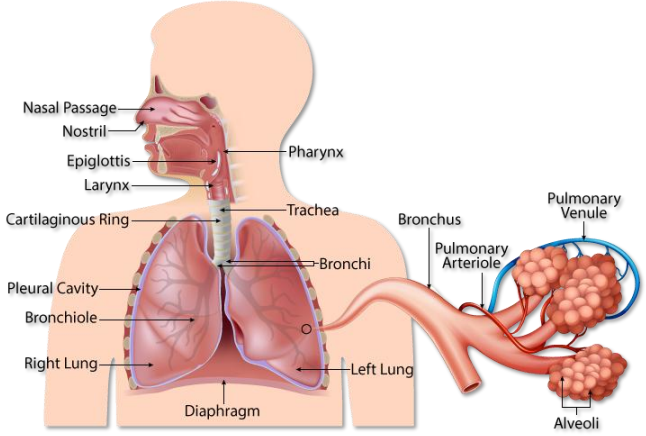CBSE Class 11-science Answered
explain human Respiratory system
Asked by ad4957216 | 04 Jan, 2023, 06:04: PM
The human respiratory system consists of the following parts:

- Nostrils: These are the two openings present at the lower end of the nose just above the upper lips. The nostrils lead to a nasal chamber through the nasal passage.
- Nasal Cavity: It is present between the cranium and the palate. It is lined with a thin, moist mucous membrane. Mucus secreted makes the air warm. Bacteria or small dust particles get entangled in the hair of the nasal passage.
- Nasopharynx: The nasal cavity opens into the nasopharynx through the internal nares. It opens into the trachea through the glottis of the larynx region.
- Larynx: The larynx is a cartilaginous box which is responsible for producing sound. Hence, it is also called the sound box. During swallowing, the glottis is covered by a thin elastic cartilaginous flap called the epiglottis which prevents the entry of food in the larynx.
- Trachea: It extends from the larynx in the neck to the bronchi in the thoracic cavity. The walls of the trachea are provided with a hyaline cartilage which prevents the trachea from collapsing.
- Bronchi and Bronchioles: The trachea divides into the right and left primary bronchi. Each primary bronchus enters the lungs of its side. After entering the lungs, the bronchi divide into secondary and tertiary bronchi. The secondary and tertiary bronchi branch into the bronchioles—terminal bronchioles and respiratory bronchioles.
- Alveoli: Each respiratory bronchiole divides to give rise to alveolar ducts which open into the alveolar sac. Each alveolar sac contains many air sacs called alveoli. They are in proximity with the blood capillaries.
- Lungs: The lungs are soft, spongy and elastic organs. They are covered by double-layered pleura. The pleural fluid present between the two pleura reduces friction on the lung surface. The lungs are situated in the thoracic chamber which is an air-tight chamber. Any change in the volume of the thoracic cavity will reflect in the pulmonary or lung cavity
Answered by Sheetal Kolte | 05 Jan, 2023, 08:08: PM
CBSE 11-science - Biology
Asked by n6991686 | 03 Nov, 2023, 07:44: PM
CBSE 11-science - Biology
Asked by ad4957216 | 04 Jan, 2023, 06:04: PM
CBSE 11-science - Biology
Asked by sunilkumarsachan800 | 09 Oct, 2021, 04:35: PM
CBSE 11-science - Biology
Asked by Manojkumar222017 | 02 Aug, 2018, 01:43: PM
CBSE 11-science - Biology
Asked by imtiyazmulla68 | 23 Apr, 2018, 12:37: PM
CBSE 11-science - Biology
Asked by Topperlearning User | 18 Jul, 2014, 02:12: PM
CBSE 11-science - Biology
Asked by Topperlearning User | 18 Jul, 2014, 02:12: PM
CBSE 11-science - Biology
Asked by Topperlearning User | 18 Jul, 2014, 02:12: PM
CBSE 11-science - Biology
Asked by Topperlearning User | 18 Jul, 2014, 02:12: PM
CBSE 11-science - Biology
Asked by Topperlearning User | 18 Jul, 2014, 02:12: PM

